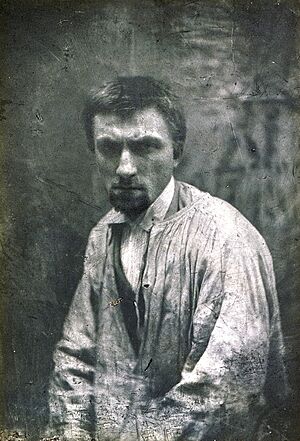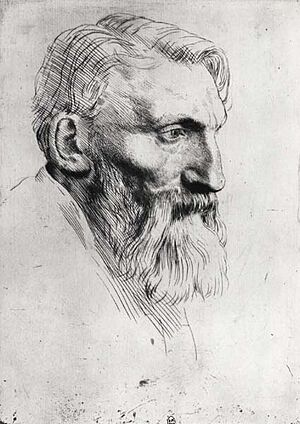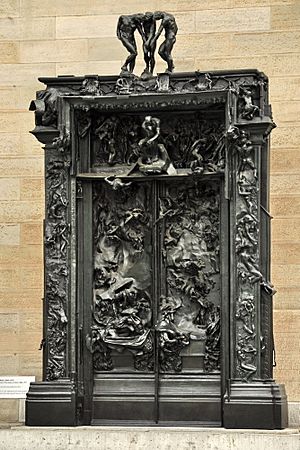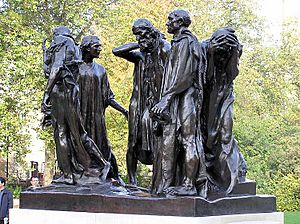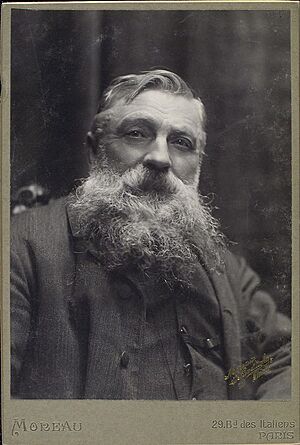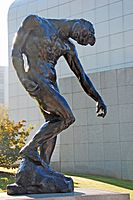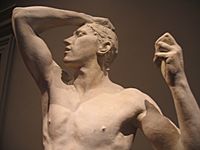Auguste Rodin facts for kids
Quick facts for kids
Auguste Rodin
|
|
|---|---|
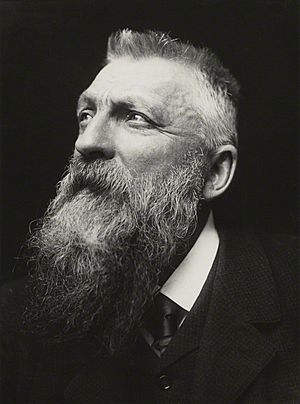
Photograph by Beresford, 1902
|
|
| Born |
François Auguste René Rodin
12 November 1840 |
| Died | 17 November 1917 (aged 77) |
| Known for | Sculpture and drawing |
|
Notable work
|
|
| Awards | Légion d'Honneur |
| Signature | |
François Auguste René Rodin (born November 12, 1840 – died November 17, 1917) was a famous French sculptor. Many people see him as the person who started modern sculpture. He is well-known for his amazing sculptures like The Thinker, The Kiss, and The Burghers of Calais.
At first, some of Rodin's sculptures were criticized. They were very different from the usual sculpture styles of his time. Even though people talked about his work, Rodin stuck to his unique style. Over time, his art became more popular with the government and other artists.
After he passed away in 1917, his sculptures were not as popular for a while. But after a few decades, his importance as an artist became clear. Today, Rodin is one of the few sculptors known by many people, even those outside the art world.
Biography
Early Life and Training
Rodin was born in Paris, France, in 1840. His family was not rich; his father worked as a police clerk. Auguste was mostly self-taught and started drawing when he was 10 years old.
From ages 14 to 17, he went to a special art and math school called the Petite École. There, he studied drawing and painting. His drawing teacher, Horace Lecoq de Boisbaudran, taught students to observe things with their own eyes. He also encouraged them to draw from memory. Rodin later said he was very thankful for his teacher's lessons.
Early Career and Family
In 1864, Rodin began living with a young seamstress named Rose Beuret. They stayed together for the rest of their lives. They had a son named Auguste-Eugène Beuret, born in 1866.
That same year, Rodin showed his first sculpture in an exhibition. He also started working for Albert-Ernest Carrier-Belleuse. Carrier-Belleuse was a successful artist who made many decorative objects. Rodin was his main assistant until 1870. He designed decorations for roofs, staircases, and doorways.
When the Franco-Prussian War began, Rodin joined the French National Guard. But he served only a short time because he was very nearsighted. The war made it hard to find work as a decorator. Rodin needed to support his family, as he struggled with money until he was about 30. Carrier-Belleuse soon asked him to join him in Belgium. There, they worked on decorations for the Brussels Stock Exchange.
Time in Belgium and Italy
Rodin planned to stay in Belgium for only a few months. But he ended up living outside of France for six years. This was a very important time in his life. He had become skilled as a craftsman. However, no one had seen his own art, which stayed in his workshop because he could not afford to cast them.
His relationship with Carrier-Belleuse became difficult. But Rodin found other work in Brussels. He also showed some of his sculptures at art shows. Rose, his partner, soon joined him there. After saving enough money, Rodin traveled to Italy for two months in 1875. He was greatly inspired by the works of Donatello and Michelangelo. Their art deeply influenced his own style. Rodin said that Michelangelo "freed me from academic sculpture."
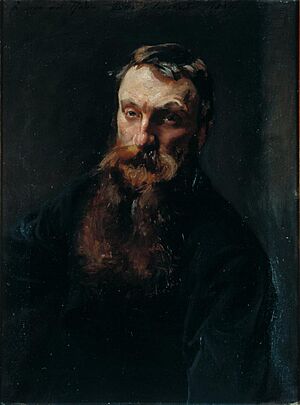
When he returned to Belgium, he started working on The Age of Bronze. This was a life-size sculpture of a male figure. Its realistic look brought Rodin attention. But some critics thought it was too realistic and accused him of casting the work directly from a living person.
Return to Paris
Rose Beuret and Rodin moved back to Paris in 1877. They lived in a small apartment on the Left Bank. Rodin faced some difficulties: his mother had passed away, and his father was blind and needed care. Rodin's 11-year-old son, Auguste, was also cared for by Rodin's sister-in-law. Rodin had not spent much time with his son for six years and would have a limited relationship with him throughout his life. His father and son later moved in with Rodin and Rose.
Rodin earned money by working with more famous sculptors. He helped them with public projects, mostly memorials and architectural pieces. He tried to win commissions for sculptures of famous people like Denis Diderot, but he was not successful. In his free time, he worked on studies for his next important sculpture, St. John the Baptist Preaching.
In 1880, Carrier-Belleuse, who was then the art director of the Sèvres national porcelain factory, offered Rodin a part-time job as a designer. Rodin accepted this offer, which was also a way for them to make up. Rodin enjoyed designing vases and table ornaments. These designs helped the factory become famous across Europe.
Growing Fame and The Gates of Hell
The art community liked Rodin's work. Friends, like the writer Léon Cladel, invited him to the Paris Salon art shows. At first, Rodin seemed shy at these events. But as he became more famous, he became known for being talkative and expressive.
A French politician named Léon Gambetta wanted to meet Rodin. When they met, Rodin impressed him. Gambetta then spoke about Rodin to several government ministers. This likely included Edmond Turquet, a high-ranking official in the Ministry of Fine Arts, whom Rodin eventually met.
Rodin's connection with Turquet was very helpful. Through him, Rodin won a big project in 1880. He was asked to create a large doorway for a planned museum of decorative arts. Rodin spent much of the next four decades working on his detailed The Gates of Hell. This was a huge doorway for a museum that was never built. Many figures from this doorway later became famous sculptures on their own. These include Rodin's most famous works, The Thinker and The Kiss.
With the museum project, Rodin also got a free studio. This gave him a new level of artistic freedom. He stopped working at the porcelain factory in 1882. From then on, he earned money from private sculpture projects.
Camille Claudel
In 1883, Rodin agreed to teach a sculpture class while sculptor Alfred Boucher was away. There, he met 18-year-old Camille Claudel. They started a strong but difficult relationship and influenced each other's art. Claudel posed for many of Rodin's figures. She was also a very talented sculptor herself. She helped him with his projects and created her own works. Her Bust of Rodin was shown at the 1892 Salon and received great praise.
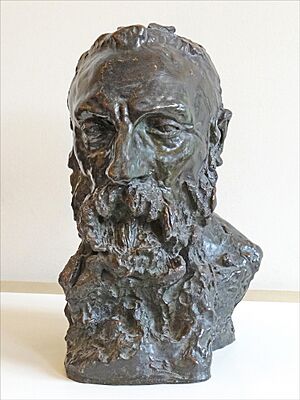
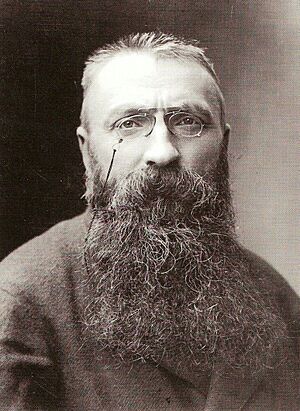
Claudel and Rodin ended their relationship in 1898.
International Recognition
By 1900, Rodin was very famous as an artist. He gained even more attention from a special display of his artwork near the 1900 World's Fair in Paris. He started getting requests from all over the world to create busts (sculptures of heads and shoulders) of important people. His assistants in his studio made copies of his works. He earned a lot of money just from these portrait commissions.
As Rodin's fame grew, many people wanted to follow his work. These included the German poet Rainer Maria Rilke and writers like Oscar Wilde. Rilke stayed with Rodin in 1905 and 1906 and helped him with administrative tasks. Rilke later wrote a book praising the sculptor.
Rodin and Rose Beuret had a modest country home in Meudon, which they bought in 1897. Many famous guests visited them there, including King Edward, dancer Isadora Duncan, and harpsichordist Wanda Landowska. A British journalist who visited in 1902 noted that the isolated location of the home matched Rodin's personality.
After 1900, Rodin often visited Great Britain. He gained many loyal followers there by the start of World War I. He met other artists and writers who supported his work. Because British artists, students, and high society were so enthusiastic about his art, Rodin gave a large collection of his works to Britain in 1914.
In 1903, Rodin was chosen as president of the International Society of Sculptors, Painters, and Engravers. He took over from the previous president, James Abbott McNeill Whistler, after Whistler's death.
In his later years, Rodin focused more on sculpting the female form. He also created many small dance studies. He made countless drawings, sketching freely without lifting his pencil from the paper or his eyes from the model.
Later Life and Death
After 53 years together, Rodin married Rose Beuret on January 29, 1917. Rose died just two weeks later, on February 16. Rodin himself was ill that year. In January, he was weak from the flu. On November 16, his doctor announced that his condition was serious due to lung problems. Rodin died the next day, on November 17, 1917, at his villa in Meudon, near Paris. He was 77 years old.
A copy of The Thinker was placed next to his tomb in Meudon. Rodin wanted this sculpture to be his headstone and epitaph.
Works
The Gates of Hell
In 1880, Rodin was asked to create a large doorway for a planned Museum of Decorative Arts in Paris. Even though the museum was never built, Rodin worked on The Gates of Hell throughout his life. This huge sculpture shows scenes from Dante's Inferno in high relief (figures that stick out from a flat surface). Rodin often did not have a clear idea of his big works at first. Instead, he worked very hard and always tried to make them perfect.
The Gates of Hell ended up having 186 figures. Many of Rodin's most famous sculptures started as designs for this large artwork. These include The Thinker, The Three Shades, and The Kiss. Later, he showed these figures as separate, independent works.
The Thinker
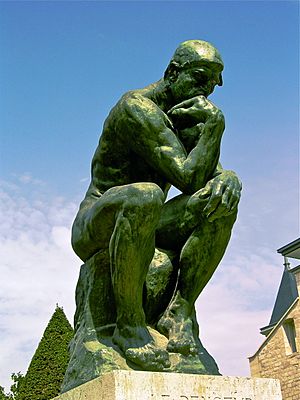
The Thinker (originally called The Poet, after Dante) became one of the most famous sculptures in the world. The first version was a 27.5-inch (700 mm) tall bronze piece. Rodin created it between 1879 and 1889. It was designed to sit above the doorway of The Gates of Hell, looking down into Hell.
While The Thinker clearly represents Dante, some people also see parts of the Biblical Adam, the mythological Prometheus, or even Rodin himself in the figure. Other people focus less on the idea of thinking. They highlight the figure's strong body and the deep emotions it shows.
The Burghers of Calais
The town of Calais had been thinking about a historical monument for many years when Rodin heard about the project. He wanted the job because he was interested in the medieval story and the patriotic theme. The mayor of Calais was very impressed when he visited Rodin's studio. Soon, the memorial was approved, with Rodin as its sculptor. It would honor six townspeople of Calais who offered their lives to save their city.
During the Hundred Years' War, the army of King Edward III attacked Calais. King Edward ordered that everyone in the town be killed. But he agreed to spare them if six important citizens came to him ready to die. They had to be bareheaded, barefoot, and have ropes around their necks. When they arrived, he ordered them to be executed. However, his queen, Philippa of Hainault, begged him to spare their lives, and he did. The Burghers of Calais shows these six men as they are leaving for the king's camp, carrying the keys to the town.
Rodin started the project in 1884, inspired by old stories of the siege. The town wanted a heroic sculpture focused on Eustache de Saint-Pierre, the oldest of the six men. But Rodin decided to show the different and complex feelings of all six men as they faced their difficult fate. One year into the project, the Calais committee was not happy with Rodin's progress. Rodin said he would rather stop the project than change his design to fit their traditional ideas. But Calais told him to continue.
In 1889, The Burghers of Calais was first shown and received great praise. It is a bronze sculpture that weighs about two short tons (1,814 kg). The figures are 6.6 ft (2.0 m) tall. The six men do not look like a united, heroic group. Instead, each one seems separate from the others, thinking and struggling with his own destiny. It is one of Rodin's most famous and admired works.
Monument to Balzac
A group of writers in Paris, the Société des Gens des Lettres, wanted a monument to the French novelist Honoré de Balzac after he died in 1850. The society asked Rodin to create this memorial in 1891. Rodin spent years developing the idea for his sculpture. The finished sculpture shows Balzac wrapped in a large robe, looking strongly into the distance with deep facial features. Rodin wanted to show Balzac at the moment he was creating a work, expressing courage, effort, and struggle.
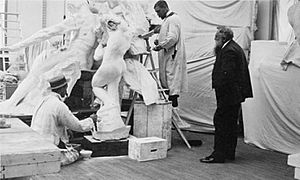
When Monument to Balzac was shown in 1898, many people reacted negatively. The society rejected the work, and newspapers made fun of it.
However, the monument also had supporters in Rodin's time. Famous artists like Claude Monet and Claude Debussy, and future Prime Minister Georges Clemenceau, signed a statement defending him. Art historian Kenneth Clark called the monument "the greatest piece of sculpture of the 19th Century, perhaps, indeed, the greatest since Michelangelo." Instead of trying to convince those who disliked it, Rodin returned the money he was paid and moved the sculpture to his own garden. After this experience, Rodin did not complete another public project. It was not until 1939 that Monument to Balzac was cast in bronze and placed in Paris.
Other Works
Rodin's most famous sculptures sometimes overshadow all the other art he created. He was a very productive artist. He made thousands of busts, figures, and sculpture pieces over more than 50 years. He also painted in oils and watercolors. The Musée Rodin (Rodin Museum) holds 7,000 of his drawings and prints. He also made one lithograph.
Making portraits was an important part of Rodin's work. It helped him gain acceptance and earn money. His first sculpture was a bust of his father in 1860. He made at least 56 portraits between 1877 and his death in 1917. Early subjects included fellow sculptor Jules Dalou and his partner Camille Claudel.
Later, when he was famous, Rodin made busts of important people of his time. These included English politician George Wyndham, Irish playwright George Bernard Shaw, Countess of Warwick, Austrian composer Gustav Mahler, former Argentine president Domingo Faustino Sarmiento, and French statesman Georges Clemenceau.
Method
Rodin had a unique way of working. Instead of having his models stand in traditional poses, he preferred them to move naturally around his studio. The sculptor often made quick sketches in clay. These were later refined, cast in plaster, and then cast in bronze or carved from marble. Rodin focused a lot on working with the clay itself.
George Bernard Shaw posed for a portrait and described Rodin's technique. He said that Rodin could create a living bust from a block of clay in just 15 minutes using only his thumb.
Shaw described how his bust changed over a month, going through "all the stages of art's evolution." He said Rodin's hand worked "not as the hand of a sculptor works, but as the work of Elan Vital." He called it "The Hand of God."
After Rodin finished his work in clay, he had skilled assistants. They would re-sculpt his pieces at larger sizes, including his big monuments like The Thinker. They also cast the clay works into plaster or bronze and carved his marbles. Rodin's main new idea was to use these multi-step processes of 19th-century sculpture, especially relying on plaster casting.
Clay can dry out and break quickly if not kept wet or fired. So, sculptors used plaster casts to save their clay creations. This was a common practice. Sculptors would show plaster casts hoping to get commissions to make the works in a more permanent material. Rodin, however, would make many plaster casts. He treated them as raw material, combining parts and figures into new sculptures with new names.
-
The Shade (1880–81), High Museum of Art, Atlanta
-
A plaster of The Age of Bronze
Legacy
Rodin left his studio and the right to make casts from his plaster works to the French government. Because he encouraged copies of his sculptures, Rodin's works are found in many public and private art collections. The Musée Rodin (Rodin Museum) was founded in 1916 and opened in 1919. It is located in the Hôtel Biron, where Rodin had lived. It holds the largest collection of his art, with over 6,000 sculptures and 7,000 works on paper. France honored him by making him a Commander of the Légion d'honneur. He also received an honorary doctorate degree from the University of Oxford.
During his lifetime, people compared Rodin to Michelangelo. He was widely seen as the greatest artist of his time. In the 30 years after his death, his popularity decreased as art styles changed. But since the 1950s, Rodin's reputation has grown again. He is now recognized as the most important sculptor of the modern era. His sculptures, which sometimes look unfinished, like The Walking Man, influenced the more abstract sculptures of the 20th century.
Rodin brought back an old purpose of sculpture: to capture the physical and mental strength of people. He freed sculpture from simply repeating old patterns. This opened the door for more experimentation in the 20th century. His popularity comes from his emotional sculptures of everyday men and women. He was able to find beauty and deep feelings in human beings. His most popular works, like The Kiss and The Thinker, are widely used outside of art as symbols of human emotion and character. To honor Rodin's artistic legacy, the Google search engine homepage showed a Google Doodle featuring The Thinker on his 172nd birthday in 2012.
Rodin had a huge influence on art. A whole generation of sculptors studied in his workshop. These include Gutzon Borglum, Antoine Bourdelle, Constantin Brâncuși, Camille Claudel, Charles Despiau, Malvina Hoffman, Carl Milles, François Pompon, Rodo, Gustav Vigeland, Clara Westhoff, and Margaret Winser. Even though Brancusi later moved away from his style, Rodin also supported the work of other sculptors. He promoted artists like Aristide Maillol and Ivan Meštrović, whom Rodin once called "the greatest phenomenon amongst sculptors." Other sculptors whose work was influenced by Rodin include Joseph Csaky, Alexander Archipenko, Joseph Bernard, Henri Gaudier-Brzeska, Georg Kolbe, Wilhelm Lehmbruck, Jacques Lipchitz, Pablo Picasso, Adolfo Wildt, and Ossip Zadkine. Henry Moore said that Rodin had a major influence on his own work.
Several films have featured Rodin as an important character. These include Camille Claudel (1988), where Gérard Depardieu played Rodin. There's also Camille Claudel 1915 from 2013, and Rodin (2017), starring Vincent Lindon as Rodin. Also, the Rodin Studios artists' cooperative housing in New York City, built in 1917, was named after him.
Images for kids
-
Rodin's signature on The Thinker
See Also
 In Spanish: Auguste Rodin para niños
In Spanish: Auguste Rodin para niños
- List of sculptures by Auguste Rodin


